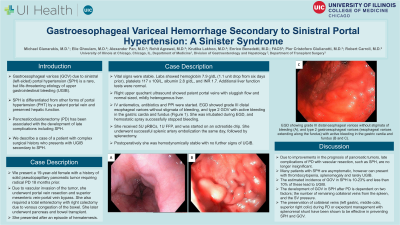Monday Poster Session
Category: GI Bleeding
P2048 - Gastroesophageal Variceal Hemorrhage Secondary to Sinistral Portal Hypertension: A Sinister Syndrome
Monday, October 23, 2023
10:30 AM - 4:15 PM PT
Location: Exhibit Hall

Has Audio

Michael Gianarakis, MD
University of Illinois at Chicago
Chicago, IL
Presenting Author(s)
Michael Gianarakis, MD, Elie Ghoulam, MD, Alexander Pan, MD, Rohit Agrawal, MD, Krutika Lakhoo, MD, Enrico Benedetti, MD, Robert Carroll, MD
University of Illinois at Chicago, Chicago, IL
Introduction: Gastroesophageal varices (GOV) due to sinistral (left-sided) portal hypertension (SPH) is a rare, but life-threatening etiology of upper gastrointestinal bleeding (UGIB). SPH is differentiated from other forms of portal hypertension (PHT) by a patent portal vein and preserved hepatic function. Pancreaticoduodenectomy (PD) has been associated with the development of late complications including SPH. We describe a case of a patient with complex surgical history who presents with UGIB secondary to SPH.
Case Description/Methods: We present a 19-year-old female with a history of solid pseudopapillary pancreatic tumor requiring radical PD 18 months prior. Due to vascular invasion of the tumor, she underwent portal vein resection and superior mesenteric vein-portal vein bypass. She also required a total enterectomy with right colectomy due to venous congestion of the bowel. She later underwent pancreas and bowel transplant.
She presented after an episode of hematemesis. Vital signs were stable. Labs showed hemoglobin 7.9 g/dL (1.1 unit drop from six days prior), platelets 117 x 109/L, albumin 2.8 g/dL, and INR 1.7. Additional liver function tests were normal. Right upper quadrant ultrasound showed patent portal veins with sluggish flow and normal sized, mildly heterogenous liver. IV antiemetics, antibiotics and PPI were started. EGD showed grade III distal esophageal varices without stigmata of bleeding, and type 2 GOV with active bleeding in the gastric cardia and fundus (Figure 1). She was intubated during EGD, and hemostatic spray successfully stopped bleeding. She received 5U pRBCs, 1U FFP, and was started on an octreotide drip. She underwent successful splenic artery embolization the same day, followed by splenectomy. Postoperatively she was hemodynamically stable with no further signs of UGIB.
Discussion: Due to improvements in the prognosis of pancreatic tumors, late complications of PD with vascular resection, such as SPH, are no longer insignificant. Many patients with SPH are asymptomatic, however can present with thrombocytopenia, splenomegaly and rarely UGIB. The estimated incidence of GOV in SPH is 10-23% and less than 10% of these lead to UGIB. The development of GOV in SPH after PD is dependent on two factors; the number of remaining collateral veins from the spleen, and the SV pressure. The preservation of collateral veins (left gastric, middle colic, superior right colic) during PD or expectant management with splenorenal shunt have been shown to be effective in preventing SPH and GOV.

Disclosures:
Michael Gianarakis, MD, Elie Ghoulam, MD, Alexander Pan, MD, Rohit Agrawal, MD, Krutika Lakhoo, MD, Enrico Benedetti, MD, Robert Carroll, MD. P2048 - Gastroesophageal Variceal Hemorrhage Secondary to Sinistral Portal Hypertension: A Sinister Syndrome, ACG 2023 Annual Scientific Meeting Abstracts. Vancouver, BC, Canada: American College of Gastroenterology.
University of Illinois at Chicago, Chicago, IL
Introduction: Gastroesophageal varices (GOV) due to sinistral (left-sided) portal hypertension (SPH) is a rare, but life-threatening etiology of upper gastrointestinal bleeding (UGIB). SPH is differentiated from other forms of portal hypertension (PHT) by a patent portal vein and preserved hepatic function. Pancreaticoduodenectomy (PD) has been associated with the development of late complications including SPH. We describe a case of a patient with complex surgical history who presents with UGIB secondary to SPH.
Case Description/Methods: We present a 19-year-old female with a history of solid pseudopapillary pancreatic tumor requiring radical PD 18 months prior. Due to vascular invasion of the tumor, she underwent portal vein resection and superior mesenteric vein-portal vein bypass. She also required a total enterectomy with right colectomy due to venous congestion of the bowel. She later underwent pancreas and bowel transplant.
She presented after an episode of hematemesis. Vital signs were stable. Labs showed hemoglobin 7.9 g/dL (1.1 unit drop from six days prior), platelets 117 x 109/L, albumin 2.8 g/dL, and INR 1.7. Additional liver function tests were normal. Right upper quadrant ultrasound showed patent portal veins with sluggish flow and normal sized, mildly heterogenous liver. IV antiemetics, antibiotics and PPI were started. EGD showed grade III distal esophageal varices without stigmata of bleeding, and type 2 GOV with active bleeding in the gastric cardia and fundus (Figure 1). She was intubated during EGD, and hemostatic spray successfully stopped bleeding. She received 5U pRBCs, 1U FFP, and was started on an octreotide drip. She underwent successful splenic artery embolization the same day, followed by splenectomy. Postoperatively she was hemodynamically stable with no further signs of UGIB.
Discussion: Due to improvements in the prognosis of pancreatic tumors, late complications of PD with vascular resection, such as SPH, are no longer insignificant. Many patients with SPH are asymptomatic, however can present with thrombocytopenia, splenomegaly and rarely UGIB. The estimated incidence of GOV in SPH is 10-23% and less than 10% of these lead to UGIB. The development of GOV in SPH after PD is dependent on two factors; the number of remaining collateral veins from the spleen, and the SV pressure. The preservation of collateral veins (left gastric, middle colic, superior right colic) during PD or expectant management with splenorenal shunt have been shown to be effective in preventing SPH and GOV.

Figure: EGD showing grade III distal esophageal varices without stigmata of bleeding (A), and type 2 gastroesophageal varices (esophageal varices extending along the fundus) with active bleeding in the gastric cardia and fundus (B and C).
Disclosures:
Michael Gianarakis indicated no relevant financial relationships.
Elie Ghoulam indicated no relevant financial relationships.
Alexander Pan indicated no relevant financial relationships.
Rohit Agrawal indicated no relevant financial relationships.
Krutika Lakhoo indicated no relevant financial relationships.
Enrico Benedetti indicated no relevant financial relationships.
Robert Carroll: Takedz – Speakers Bureau.
Michael Gianarakis, MD, Elie Ghoulam, MD, Alexander Pan, MD, Rohit Agrawal, MD, Krutika Lakhoo, MD, Enrico Benedetti, MD, Robert Carroll, MD. P2048 - Gastroesophageal Variceal Hemorrhage Secondary to Sinistral Portal Hypertension: A Sinister Syndrome, ACG 2023 Annual Scientific Meeting Abstracts. Vancouver, BC, Canada: American College of Gastroenterology.
